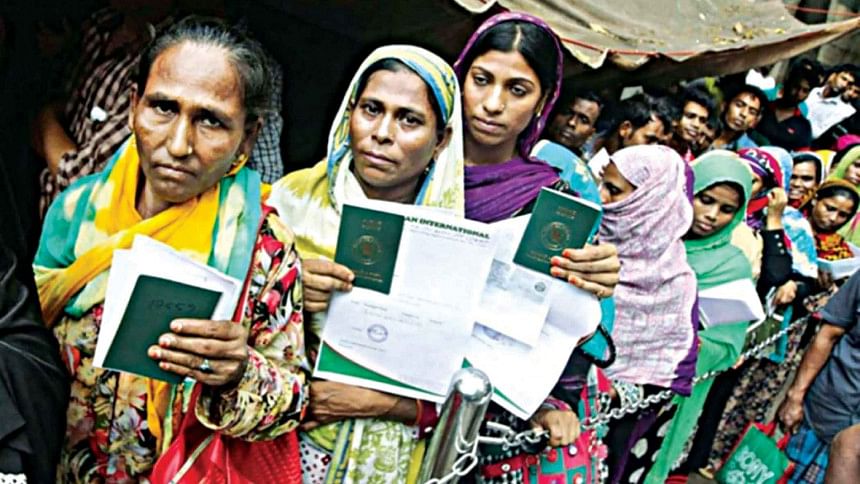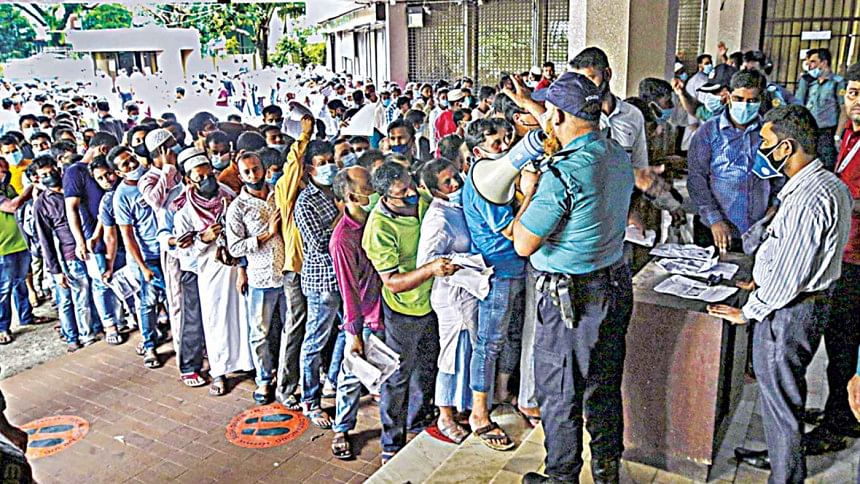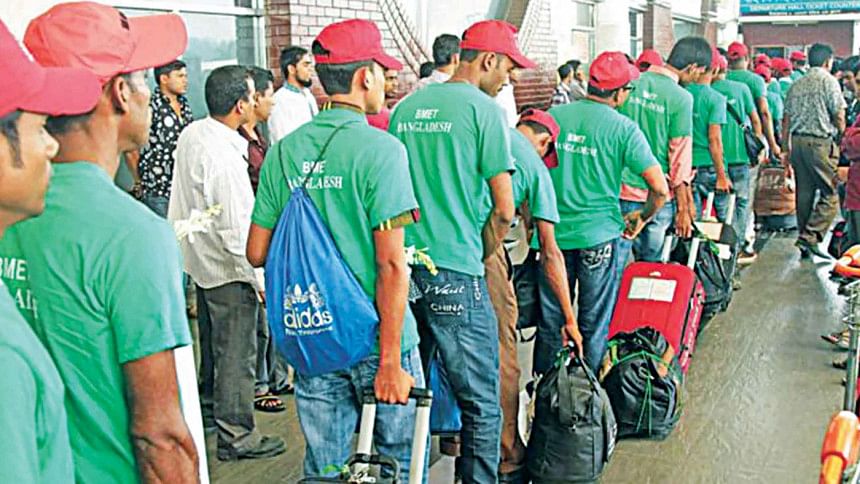What is the future of our migrant workers?

Lisbon's riverfront Praça do Comércio is one of Europe's largest city squares and a major attraction in tiny Portugal. The cobbled streets leading to its stone entrance are lined with typical tourist traps: trendy boutiques, sidewalk cafes, and gift shops, nothing that genuinely defies expectations. The welcome surprise, the real twist, comes when you walk through the quaint doors and the shopkeeper greets you in, of all languages, Bangla.
In the sixteenth century, seafaring Portuguese were the first Europeans to build an enclave in Chattagram, but there is no Portuguese embassy in contemporary Bangladesh. Fortunately, diplomatic relations are on an upswing. Bangladesh opened a mission in 2012 to serve its migrant population. And in downtown Lisboa, our people are everywhere.
Though the days are long, the work relentless, and the economy permanently sluggish, Lisbon's Bangladeshi community seems to be thriving. Young Bangladeshi men (and occasionally women) staff convenience stores, serve Peri-Peri chicken in black aprons, and assemble on the streets to discuss Bangladeshi politics during breaks.
The migrant workers I met throughout the country told me they find it easier to get residency documents here before moving further inland into Europe. Finding me a clueless tourist on the Praça, they introduced me to pastéis de nata, an eggy, custardy tart. They sold me cork and ceramic souvenirs at remarkable non-tourist discount. On my last evening, I stood on the shores of the Tagus River as a young Bangladeshi man rushed to work. I marvelled at how thousands of the world's most under resourced people persevere through sheer will, setting up new lives in alien worlds, steadily turning the tides of history.
We are living, of course, in the age of migration. Barring Covid, millions of people are typically on the move each year to escape war, the effects of climate change, to find jobs. This is a stage where Bangladesh, the world's eighth-most populous country, has a starring role. Of the estimated 164 million migrant workers worldwide today, 10 million come from Bangladesh (spread across 160 countries). That's how many people there are in Portugal altogether.
With every passing decade since Independence, families, communities, and, increasingly, entire districts in our country have become more reliant on the remittance migrants send back through official and unofficial channels. According to the World Bank, for each additional 0.1 percent of a district's population that migrated internationally between 2000 and 2016, poverty in that district fell by 1.7 percent in Bangladesh. Hard-earned dollars and dinars pay school and hospital fees, build pucca homes, and help finance passage for more relatives and friends to move overseas. In addition to RMG, remittance inflow has for years served as a veritable pillar of our economy, pumping in USD 21.9 billion last year amidst the global pandemic.
Close to half a million Bangladeshis move abroad every year searching for work. They leave by land, sea, and air, with and without papers, on expensive and dangerous journeys. Despite considerable effort from the government and the development sector in recent years to institutionalise and regulate it, migration remains a precarious endeavour, often a desperate jump from poverty into global systems of slavery, human trafficking, and exploitation. Many workers die along the way. Most find work that is low-skilled and physically and mentally gruelling, often at the fringes of their host societies.
In Qatar, where migrant workers are building astonishing stadiums for the 2022 FIFA World Cup, up to 4,000 workers, may die from the work before the first ball is kicked. "I am not myself anymore, mother/come see how I live," writes Bangladeshi migrant worker and poet Md Mukul Hossine, in his evocative poetry collection Me Migrant.

Driving these massive outflows of humanity is a growing, restless, and underserved young population in Bangladesh, where 65 percent of the population today is of working age. Countries like South Korea have strategically invested in education and infrastructure during similar population trends (known as a demographic dividend), building deep foundations for prosperity. Giving a sizeable working population quality education, secure employment, stable healthcare can lead to substantial national transformation within a single generation. In the early 1950s, Korea's national income (GNI) per capita was USD 67. In 2018, it crossed USD 30,000. In Bangladesh, we are watching our demographic dividend go by almost in a state of paralysis. Human capital levels remain low throughout the country. And while our economy has shown steady growth in recent years, it seems to have nearly bypassed young Bangladeshis. The majority of workers (85 percent) remain within the informal economy; youth unemployment is significantly higher than the national average. The percentage of youth who are not in any form of education, economic activities, and training (NEET) is growing, civic engagement is low, and disaffection among youth is high.
Meanwhile, the Holey Artisan and subsequent attacks demonstrate the deepening polarisation across identity, gender, and religion in the country's young population. Add to this the spectre of climate change and widening income inequality, and you begin to see the hopelessness and frustration pervading the young population. When Bangladeshis leave the country in droves, it is not because they want to. Overwhelmingly, their motivation is their family's welfare, an ailing parent, a sibling or a child who needs an education. They leave behind villages, towns, and cities with limited opportunities to build a life. They leave because they have to.
Unfortunately, we send them away with little preparation for the world beyond our borders. Migrant workers from Bangladesh are mostly unskilled and undertrained, forced to navigate new countries with limited information. Wherever they go, migrants typically take up the jobs that locals will not do. In most societies, they remain segregated, outside their host society's social safety net and legal protections, particularly vulnerable to the shocks to their host economy. When war broke out in Libya in 2011, 60,000 Bangladeshis, mostly young men were stranded, deserted by their employers and left to fend for themselves. Combined efforts of the government, the IOM, and NGOs were required to evacuate thousands who brought back horrifying tales of conflict and torture.
Even before the Covid crisis hit, rising nationalism and right-wing politics across the world was already reshaping Bangladesh's labour migration prospects. Between 2014 and 2016, for example, the Gulf countries experienced a recession as oil prices fell. With economies slowing, countries rushed to protect domestic jobs. Oman banned foreigners from 80 different categories of employment. Using the slogan "Let's Put The 'Saudi' In Saudisation," Saudi Arabia embarked on a campaign to increase its own citizens' employment. Last year, the Bangladesh mission there predicted that up to 1 million migrants are at risk of being deported.

Then came the Covid crisis. Hundreds of thousands of workers were laid off, furloughed, or unable to go work even in the most advanced economies. Without jobs or savings to secure flights, many faced unprecedented hunger and infection levels, virtually untouched by massive stimulus packages rolled out to provide relief. Even in wealthy Dubai, where the government mandated that employers support workers with food and accommodation, news of starvation and financial stress in the migrant community made global headlines. In Singapore, infection rates among migrant workers infections were three times higher than local Singaporeans.
By the middle of the year, countries began asking Bangladesh to take its workers back. Brac's Migration Program estimates that 400,000 migrant workers returned home last year (up from an estimated 50,000 returning workers in a typical year). They returned to a nation far more impoverished than the one they left. According to the South Asian Network on Economic Modeling (SANEM), poverty rates have doubled in Bangladesh because of Covid. Migrant workers have few employment prospects today, and studies show that their families' monthly expenditures have dropped sharply. Reports of social stigma and ostracisation, based on fears about Covid-19, confirm that migrant workers will remain an at-risk population through the Covid recovery period.
In recent decades, Bangladesh has moved to regulate migration, establishing a separate ministry in 2001 and instituting a central national policy on migration, the Expatriate Welfare and Overseas Employment Policy. The country has long been criticised for focusing more on migrants who leave than those who return after service abroad. In the wake of Covid-19, the government has, therefore, established a Tk 700 crore fund aimed at rehabilitation, offering returnees investment credit at 4 percent interest (though complaints remain about the complicated process of obtaining credit).
Globally, Bangladesh has disbursed close to Tk 10 crores to its workers through various missions for immediate relief and announced pockets of employment opportunities in Africa and Europe, particularly in agriculture. Under a new programme in Malaysia, undocumented Bangladeshi workers will have the chance to be regularised and recruited by employers. The government and ILO Bangladesh are working to measure and certify skillsets to help migrants reintegrate back home and plan for future migration.
What is missing in the broader debate on labour migration is a promise of investment in the capacity of systems and institutions that regulate migration. For example, in key host countries, Bangladeshi missions are understaffed, notably lacking female labour attachés to support female migrants. Missing, also, is any inkling of deep investment in the capacity of our people themselves to capitalise on our demographic dividend and help migrants make the most of the opportunities they find. Our allocation in the national budget for education remains unchanged as a percentage of GDP. Covid may lead to increased labour migration levels in a few years, but lack of investment in learning will keep future migrant workers trapped in the same challenges as today.
A few years ago, I stood at the carousel next to a migrant worker from Dubai at the Dhaka airport where our luggage was inexplicably delayed. After two hours had passed, we found ourselves sitting on the trolleys with no clue if we would find our luggage that day. "Bangali hoye jonmaye bhul korsilam" (it was a mistake to have been born a Bengali), he told me with a blank expression.
Without long-term investment in the systems of migration and in the very people who use them, it seems unlikely that we can promise our migrant workers the dignity they deserve.

Shoaib Alam serves as the Chief of Staff at Teach For Bangladesh.

 For all latest news, follow The Daily Star's Google News channel.
For all latest news, follow The Daily Star's Google News channel. 



Comments